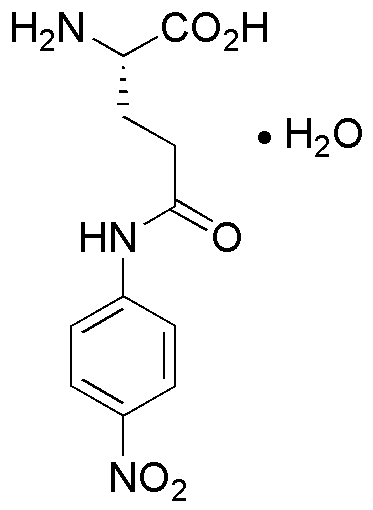L-g-Glutamyl-p-nitroanilide monohydrate is widely utilized in research focused on:
- Enzyme Activity Assays: This compound serves as a substrate in enzyme assays, particularly for glutaminase and other related enzymes, allowing researchers to measure enzyme activity effectively.
- Biochemical Research: It is used in studies related to protein interactions and metabolic pathways, providing insights into cellular processes and potential therapeutic targets.
- Drug Development: The compound plays a role in the development of pharmaceuticals by acting as a model substrate for testing drug interactions and efficacy in biological systems.
- Diagnostic Applications: It can be employed in diagnostic tests for certain diseases, helping to identify enzyme deficiencies or abnormalities in metabolic processes.
- Educational Purposes: This chemical is often used in academic laboratories for teaching purposes, demonstrating enzyme kinetics and biochemical reactions in a controlled environment.
General Information
Properties
Safety and Regulations
Applications
L-g-Glutamyl-p-nitroanilide monohydrate is widely utilized in research focused on:
- Enzyme Activity Assays: This compound serves as a substrate in enzyme assays, particularly for glutaminase and other related enzymes, allowing researchers to measure enzyme activity effectively.
- Biochemical Research: It is used in studies related to protein interactions and metabolic pathways, providing insights into cellular processes and potential therapeutic targets.
- Drug Development: The compound plays a role in the development of pharmaceuticals by acting as a model substrate for testing drug interactions and efficacy in biological systems.
- Diagnostic Applications: It can be employed in diagnostic tests for certain diseases, helping to identify enzyme deficiencies or abnormalities in metabolic processes.
- Educational Purposes: This chemical is often used in academic laboratories for teaching purposes, demonstrating enzyme kinetics and biochemical reactions in a controlled environment.
Documents
Safety Data Sheets (SDS)
The SDS provides comprehensive safety information on handling, storage, and disposal of the product.
Product Specification (PS)
The PS provides a comprehensive breakdown of the product’s properties, including chemical composition, physical state, purity, and storage requirements. It also details acceptable quality ranges and the product's intended applications.
Certificates of Analysis (COA)
Search for Certificates of Analysis (COA) by entering the products Lot Number. Lot and Batch Numbers can be found on a product’s label following the words ‘Lot’ or ‘Batch’.
*Catalog Number
*Lot Number
Certificates Of Origin (COO)
This COO confirms the country where the product was manufactured, and also details the materials and components used in it and whether it is derived from natural, synthetic, or other specific sources. This certificate may be required for customs, trade, and regulatory compliance.
*Catalog Number
*Lot Number
Safety Data Sheets (SDS)
The SDS provides comprehensive safety information on handling, storage, and disposal of the product.
DownloadProduct Specification (PS)
The PS provides a comprehensive breakdown of the product’s properties, including chemical composition, physical state, purity, and storage requirements. It also details acceptable quality ranges and the product's intended applications.
DownloadCertificates of Analysis (COA)
Search for Certificates of Analysis (COA) by entering the products Lot Number. Lot and Batch Numbers can be found on a product’s label following the words ‘Lot’ or ‘Batch’.
*Catalog Number
*Lot Number
Certificates Of Origin (COO)
This COO confirms the country where the product was manufactured, and also details the materials and components used in it and whether it is derived from natural, synthetic, or other specific sources. This certificate may be required for customs, trade, and regulatory compliance.


